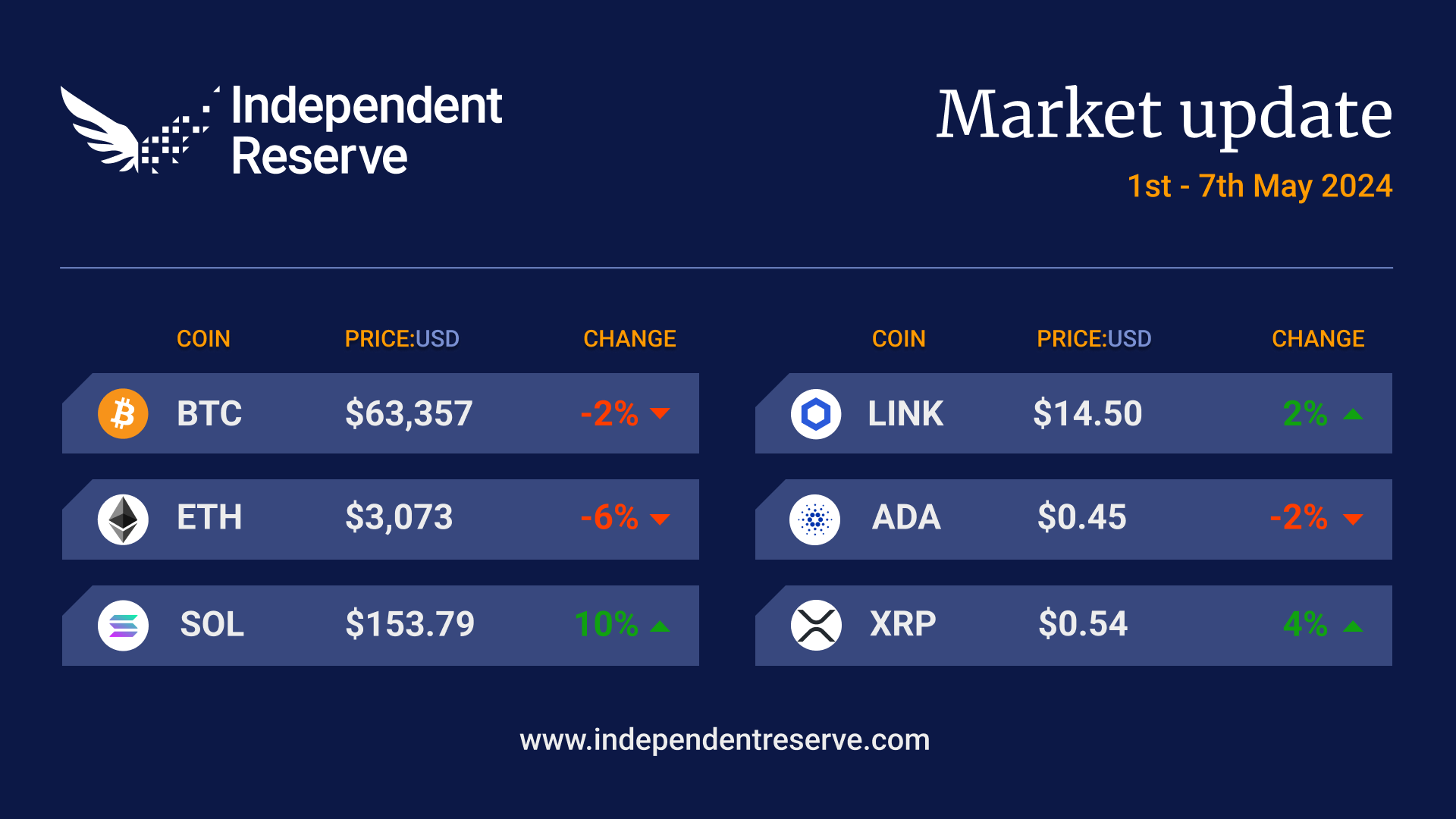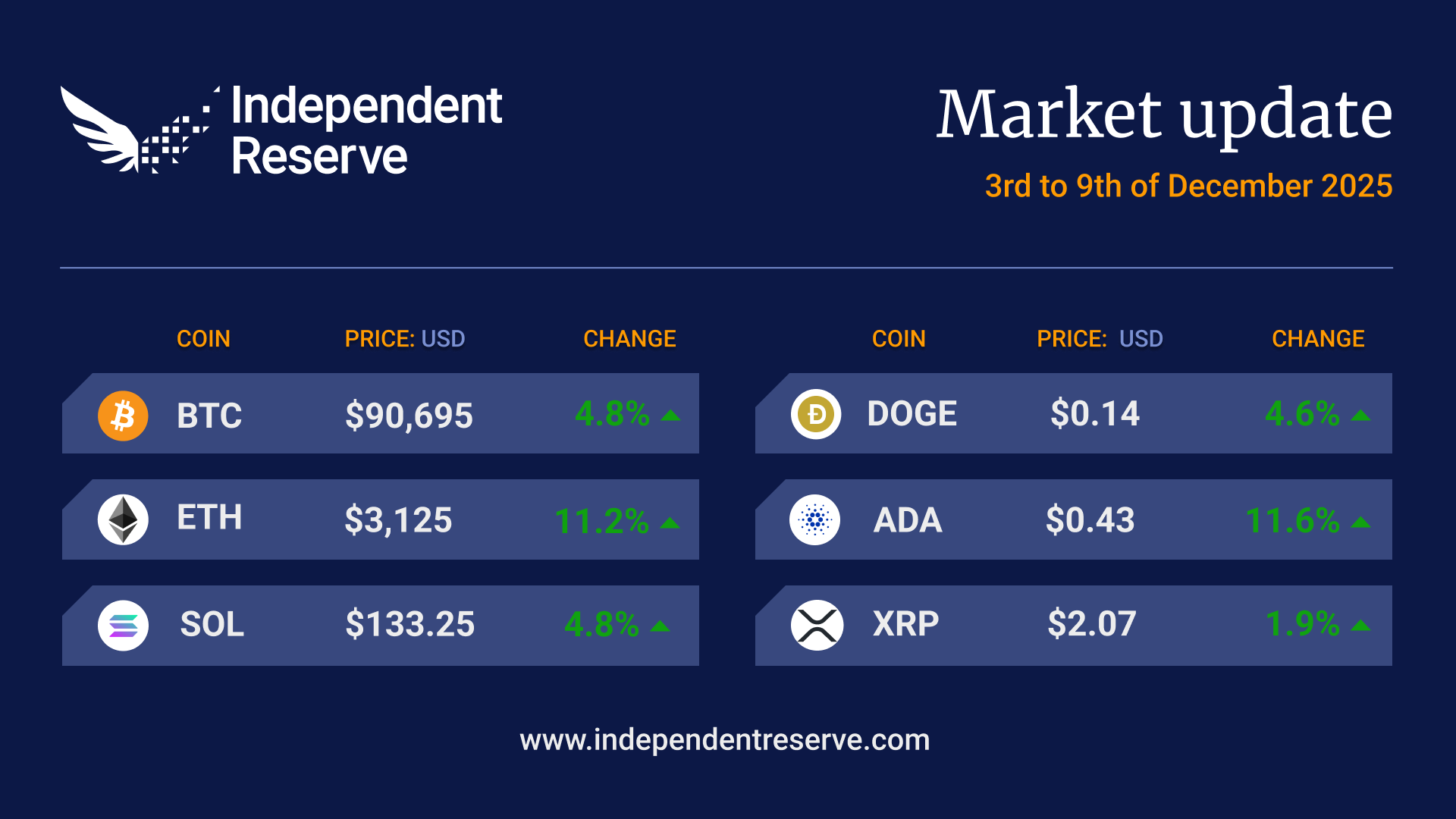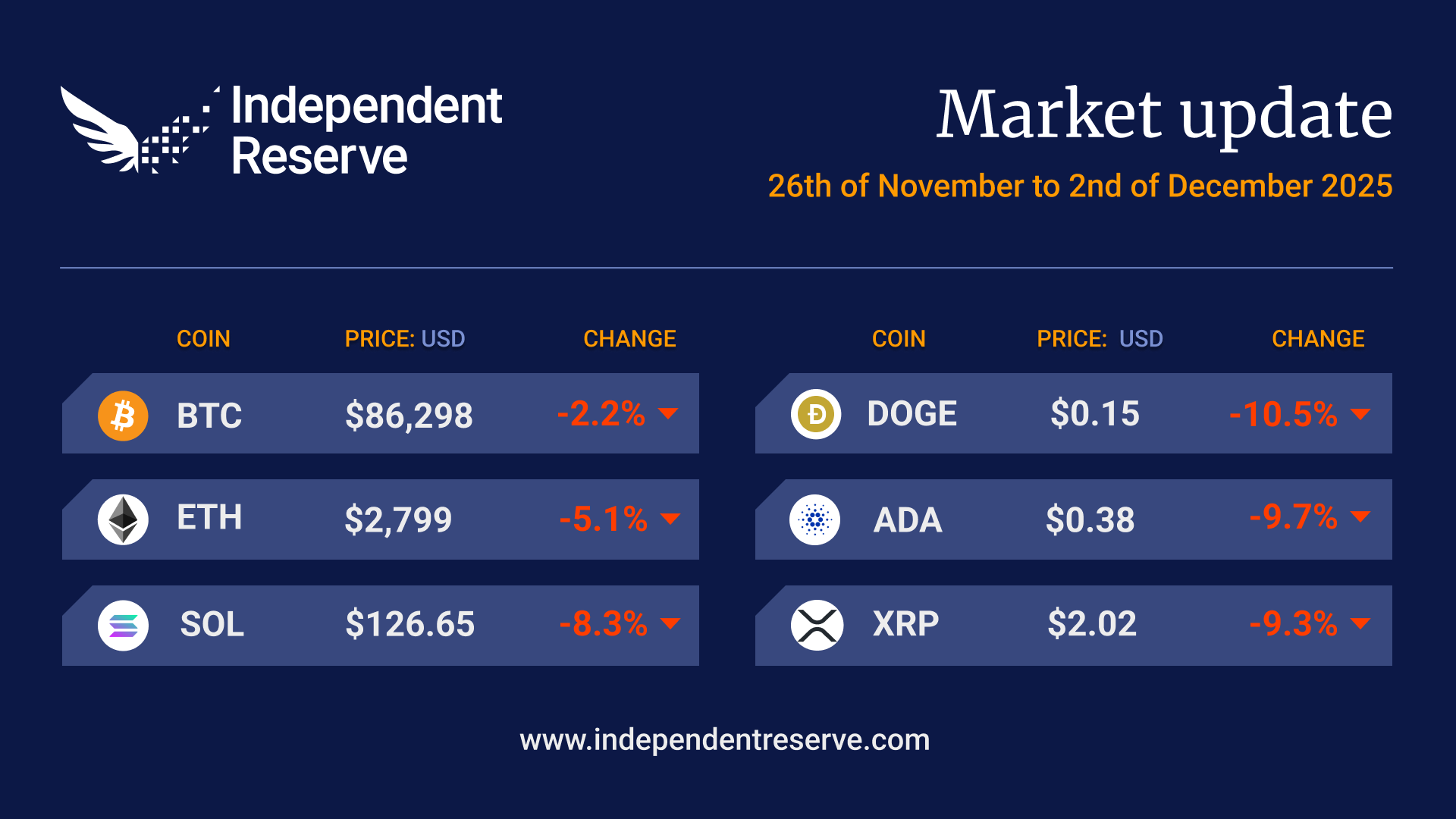In Markets
After a dismal few days in which Bitcoin plunged to A$87.5K (US$56.8K) as flows to the Bitcoin ETFs dried up and inflation fears surged, everything took a sharp turn for the better on Saturday. Bitcoin rose 5% off the back of cooler-than-expected US jobs numbers, easing inflation and interest rate fears. Bitcoin has just notched up one billion transactions, the 200-day moving average has just hit a new all-time high, and the ETFs broke a long streak of outflows with hundreds of millions added on Friday. Former Bitmex CEO Arthur Hayes believes we’ve seen the local bottom, and he predicts range-bound price action between US$60K and US$70K (A$90K to A$106K) until August. Bitcoin finishes the week relatively flat at A$95,182 (US$63.5K), while Ethereum lost 3.9% over the week to trade around A$4,620 (US$3,081). Solana gained 13.1%, XRP was up 5.1%, Dogecoin (9.4%), Cardano and Shiba Inu were flat. The Crypto Fear and Greed Index is at 71 or Greed.

From the IR OTC Desk
Macroeconomic data remains the core driver of cryptocurrencies; which have maintained their status as a risk asset. Last week, we highlighted our expectation that both labour market data and fiscal policy will become the key inputs to monetary policy decision making. On lookback, this has proven accurate with the market exhibiting significantly greater pricing movement post the US labour market data than post the US Federal Open Market (FOMC) federal funds decision. Counterintuitively, we expect that weak economic data will likely be positive for risk asset pricing going forward, with softer data generally reducing yields and inflation.
In brief summary of the FOMC meeting (May):
- Chair Powell gave no indication of federal funds rate cuts this year, maintaining a stance of data dependency.
- Beginning in June, the FOMC will reduce their Treasury bond redemptions from USD 60bn per month to USD 25bn per month; and maintain their RMBS purchases at USD 35bn per month.
- The FOMC has a statutory mandate of maximum employment and stable prices.
Last week’s key economic data centred around the US labour market. Mainly: the Employment Cost Index QoQ (Q1) which accelerated to 1.2% from 0.9%; JOLTs Job Openings (March) which printed softer at 8.488M versus 8.813M in February; and the all important Non-Farm Payrolls (April) which came in at 175K versus a market expectation of 243K. This saw an increase in the unemployment rate from 3.8% in March to 3.9% in April. At the margin, the US labour market was deemed to have softened, causing risk assets to appreciate at the end of last week.
In Australia, today marks the Reserve Bank of Australia’s (RBA) May meeting. Critical to their decision making was the Q1 inflation data (released last month), which surprised to the upside – printing 1% in Q1 for the Trimmer Mean CPI QoQ. At today’s meeting the RBA have communicated:
“The path of interest rates that will best ensure that inflation returns to target in a reasonable timeframe remains uncertain and the Board is not ruling anything in or out. The Board will rely upon the data and the evolving assessment of risks.”
The RBA has maintained the current cash rate target of 4.35%.
In cryptocurrencies, ETF flows remain critical to the price action of the underlying. For the time being, ETF flows appear sensitive to global macro events – an important change in the way cryptocurrencies are now profiling relative to other risk assets.
On the OTC desk, it is still too early to suggest whether days of positive US BTC ETF flow are translating into days of increased on-desk activity – although we continue to track this relationship. Stable coin flows remain broadly unperturbed to broader world events. With the price action of BTC range bound, alt flow has remained on the sidelines. For now, positive carry (yield earning plays) and stable coin flows make sense…
For any further information, please feel free to reach out.
In Headlines
SEC takes aim at Robinhood
You’d be forgiven for thinking the SEC is getting paid per Wells Notice, as it just fired another one at Robinhood Crypto. The popular trading app, which came to prominence amid the meme stock boom in the pandemic, said the SEC warned that it is likely to sue the platform over alleged securities violations. Robinhood believes the crypto assets listed, including Bitcoin, Ether, Doge and Shiba Inu, are not securities. Crypto lawyer Jake Chervinsky said the SEC had sent an “astonishing” number of Wells Notice to crypto firms in recent months and that it was “hard to imagine” it has the resources to pursue them all. He argued this meant it was likely “abusing the Wells process as a scare tactic.”
SEC won’t approve any more crypto ETFs: Saylor
Bitcoin maximalist Michael Saylor (who now controls more BTC than any country) told the MicroStrategy World 2024 conference that no other cryptocurrency will land an ETF. “Ethereum is deemed to be a crypto asset security, not a commodity. After that, you’re gonna see that Ethereum, BNB, Solana, Ripple, Cardano, everything down the stack is just crypto-asset securities unregistered… None of these tokens will ever be wrapped by a spot ETF, none of them will be accepted by Wall Street,” Saylor said. The SEC is investigating whether Ether is a security (although that wouldn’t necessarily prevent an Ether ETF as most ETFs hold securities). Still, the XRP token has already been found to not be a security by Judge Analisa Torres last year. Today, the SEC punted a decision on Invesco Galaxy’s spot Ether ETF application to July, making the possibility of an Ether ETF approval in late May even more remote.
ETFs all green on Friday
After 80-odd days of losing billions to outflows — more than half its entire AUM — the Grayscale Bitcoin Trust actually received US$63 million (A$95.1M) inflow on Friday. The day also broke a seven-day streak of outflows for the ETFs as a group, with a net US$378 million (A$571M) added, including a whopping US$102.6M (A$155M) into Fidelity’s ETF. Franklin’s ETF also had its best day yet with US$60.9M (A$92M). On Monday, Grayscale notched up another tiny but positive inflow.
Hong Kong Bitcoin and Ether ETFs underwhelm
The Hong Kong Bitcoin and Ether ETFs have disappointed sky-high expectations, but were relatively successful in limited local ETF terms. The ETFs were seeded with US$292.7 million (A$442M) and so far have notched up US$22.5M (A$34M) inflows — and even suffered an outflow on one of three trading days.
Address poisoning attack nets tens of millions
It’s best practice to always do test transactions when moving large amounts of cryptocurrency. CertiK reports one crypto wallet lost US$69.3M (A$104M) of wrapped Bitcoin by not following this simple rule. The scam was an Address Poisoning attack – which is where a scammer sends a tiny amount of crypto to your wallet from an address that looks similar to one of yours, in the hope you’ll accidentally copy it from your history and send funds to it. Amazingly, this works.
ASIC wins against Qoin
The Australian Securities and Investments Commission scored a victory in its case against the developers of Qoin — a network of merchants rewarded in tokens that were supposedly spendable throughout the network. The judge ruled the centralised Qoin wallet is a financial product and requires a licence, but declined to make the same ruling about the vaguely decentralised blockchain itself. Piper Alderman’s Michael Bacina analysed the case here.
Big players look at ETFs
BlackRock’s head of crypto Robert Mitchnick, says some huge players are actively looking at tipping funds into its Bitcoin ETF. “Many of these interested firms—whether we’re talking about pensions, endowments, sovereign wealth funds, insurers, other asset managers, family offices—are having ongoing diligence and research conversations,” he said. Norway and Saudi Arabia’s wealth funds both top US$1T (A$1.5T), while globally, pension funds control US$60.6 trillion (A$91.5T) in assets.
CZ gets 4 months
Chanpeng Zhao, the founder of Binance has been sentenced to four months behind bars for allowing lax controls on money laundering at the exchange. No banker has ever gone to jail for similar breaches, but the prosecutors sought 36 months. Onlookers were surprised at the relatively short sentence, and there were rumours that he cooperated with authorities in return for leniency.
Cycle playing out as foretold
Onchain analyst Philip Swift this week posted a chart of the MVRV Z score (Market Value to Realised Value metric), showing the recent pullback in the Bitcoin price came after it hit the 2-3 zone. He pointed out the exact same “mid-cycle resistance” had been seen in three past cycles, before the price skyrocketed to new ATHs. The chart has also shown promise for picking likely tops in the price (above 6 gets into the danger zone), so bookmark it as one possible indicator of when to take profits.


